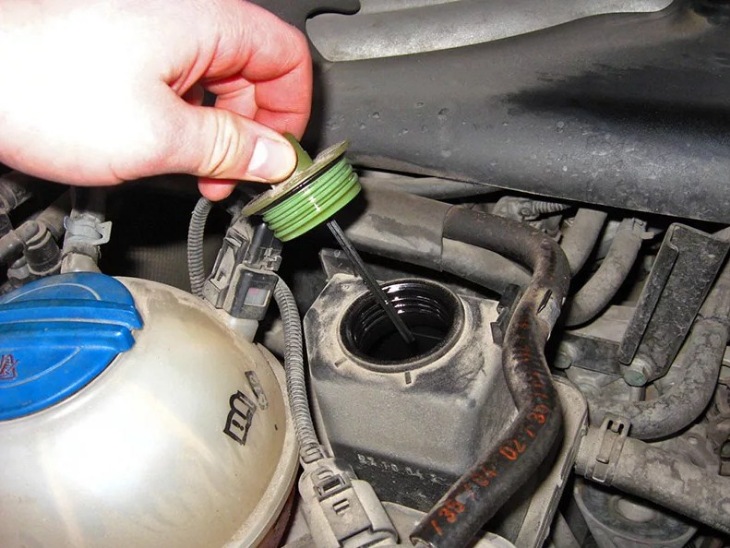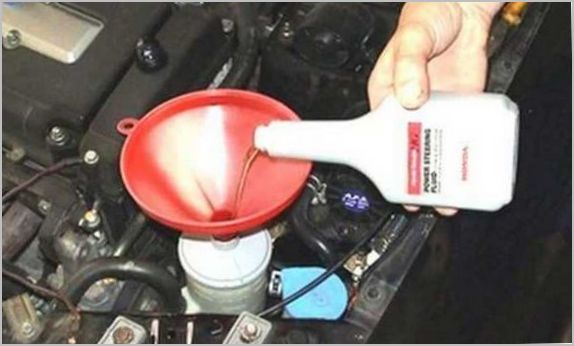
Power steering fluid change, when and how to do it
Content
On heavy trucks, power steering was installed back in the 30s of the last century. The first passenger cars with power steering appeared after World War II.
The widespread introduction of MacPherson type front suspension in combination with rack and pinion steering caused a rapid spread of hydraulic systems, since the steering rack required a lot of effort from the driver when turning the steering wheel.

Currently, hydraulic devices are being replaced by electric power steering.
What is power steering fluid
The power steering is a closed volumetric hydraulic drive system in which the high pressure of the working fluid created by the pump moves the actuators that control the wheels.
The power steering fluid is a special oil.
The manufacturer indicates the type of oil (mineral, semi-synthetic, synthetic) and the trade mark (name) in the vehicle operating instructions.
When and in what cases is the working fluid replaced.
In the closed hydraulic system of the power steering, the working fluid is subjected to significant temperature effects, contaminated with wear products of the mechanisms. Under the influence of natural aging, the base oil and additives lose their properties.
The main disadvantage of all hydraulic boosters is that the high pressure pump runs continuously while the engine crankshaft rotates. Whether the car is moving or standing in a traffic jam, the pump rotor is still spinning, its blades rub against the body, triggering the resource of the working fluid and the mechanism itself.
An external inspection of the power steering and steering mechanism must be carried out at each MOT or every 15 thousand kilometers, controlling the oil level in the tank and maintaining it at the “max” mark.

It is also recommended to regularly clean the “breathing” hole in the tank cap.
All hydraulic oils have a very low volatility, so slight level fluctuations are most likely caused by temperature changes in the volume of the hydraulic fluid. If the level drops below the “min” mark, oil must be topped up.
Some sources recommend topping up with Motul's high-tech Multi HF hydraulic oil. Unfortunately, this “market novelty” is made on a fully synthetic basis; it is not recommended to mix it with mineral oils.
A persistent drop in oil level, even after topping up, can be caused by easy-to-find system leaks. As a rule, the working fluid leaks through damaged or worn pump drive shaft seals, spool valve seals and loose line connections.
If the inspection revealed cracks in the outer shell of the supply and return hoses, leaks from the fittings of the high-pressure hoses, the operation of the car should be immediately stopped, the oil should be drained and the defective elements should be replaced without waiting for their failure.
At the end of the repair, fill in new hydraulic oil.
In addition, the hydraulic fluid in the hydraulic booster must be changed if it has lost its original color and has become cloudy.

If the power steering is in good condition, a high-quality working fluid can last up to five years, its complete replacement will be needed no earlier than after 60-100 thousand kilometers.
Synthetic oils last longer than mineral oils, but replacing them, and even flushing the system, will cost the owner much more.
What kind of oil to fill in the hydraulic booster
Indicating the type and brand of working fluid in the operating instructions, the car manufacturer took into account not only the reliability of the power steering system, but also its own economic interest.

That is why, for example, Volkswagen AG recommends green PSF Pentosin fluid for all its models. Its composition and additive package are so specific that replacement with any other is not recommended.
For liquids of other "colors" - red or yellow - it is easy to choose mineral and semi-synthetic analogues of the PSF and ATF classes.
Very good and almost universal is the transparent DEXRON III (CLASS MERCON), an inexpensive ATF grade mineral oil produced by Eneos that meets all GM requirements. Produced in cans, which excludes counterfeiting.
The use of synthetic ATF fluids intended for automatic transmissions, no matter how servicemen praise them, should only be based on the direct instructions of the manufacturer.
Replacing fluid in power steering
Adding oil to the tank is not particularly difficult and any owner can do it on their own.
Draining the oil, repairing the power steering with the replacement of its individual components and parts to eliminate leaks, and then filling in new oil is a rather complicated procedure and it is recommended to entrust it to specialists.
An oil change at the end of its service life is quite affordable if the owner has the opportunity to use a viewing hole or overpass.
About 1,0 liters of oil is placed in the power steering system of a conventional passenger car. Hydraulic fluids are supplied to the distribution network in containers with a capacity of 0,94-1 l, so at least two “bottles” must be purchased.
Replacement procedure
Preparatory work:
- Install the car on a viewing hole or on a flyover.
- Raise the body with two jacks and hang out the front wheels, having previously installed wheel chocks.
- Remove the engine underbody protection.
The actual oil change:
- Remove the tank without disconnecting the hoses from it, unscrew the plug. Tilt the tank, pour the old oil out of it into the prepared container. If the tank body is collapsible, remove the dampener and filter from it. Leave the reservoir hanging upside down over the oil collection container.
- Turn the steering wheel from lock to lock several times in both directions. The oil remaining in the spool and the cavity of the steering rack will flow out into the reservoir and further along the “return” hose.
- Unscrew the plug on the pump, under which the pressure relief valve is located, remove the valve (save the copper ring under the plug!).
- Wash all removed parts - filter, mesh, valve - in clean oil, using a brush, and blow with compressed air.
Attention! Do not dismantle the pressure relief valve, do not turn the adjusting screw!
- Rinse and purge the inside of the tank.
When washing parts, do not use the same "portion" of oil several times.
- Install the cleaned filter and mesh in the tank, fix the tank in place.
- Lubricate the valve o-ring with clean oil and carefully install it into the pump housing. Wrap the cork, after putting a copper ring on it.
- Pour new oil into the tank up to the “max” mark.
- Start the engine, turn the steering wheel once from lock to lock. Top up with new oil again up to the upper mark.
- Rotate the steering wheel to the extreme positions, expel the remaining air from the system. Top up the oil level if necessary.
- Stop the engine. Wrap the tank cap, after cleaning the "breathing" hole in it.
Reinstall the crankcase protection. Remove jacks, wheel chocks.
Power steering oil change completed.
Have a good trip!
